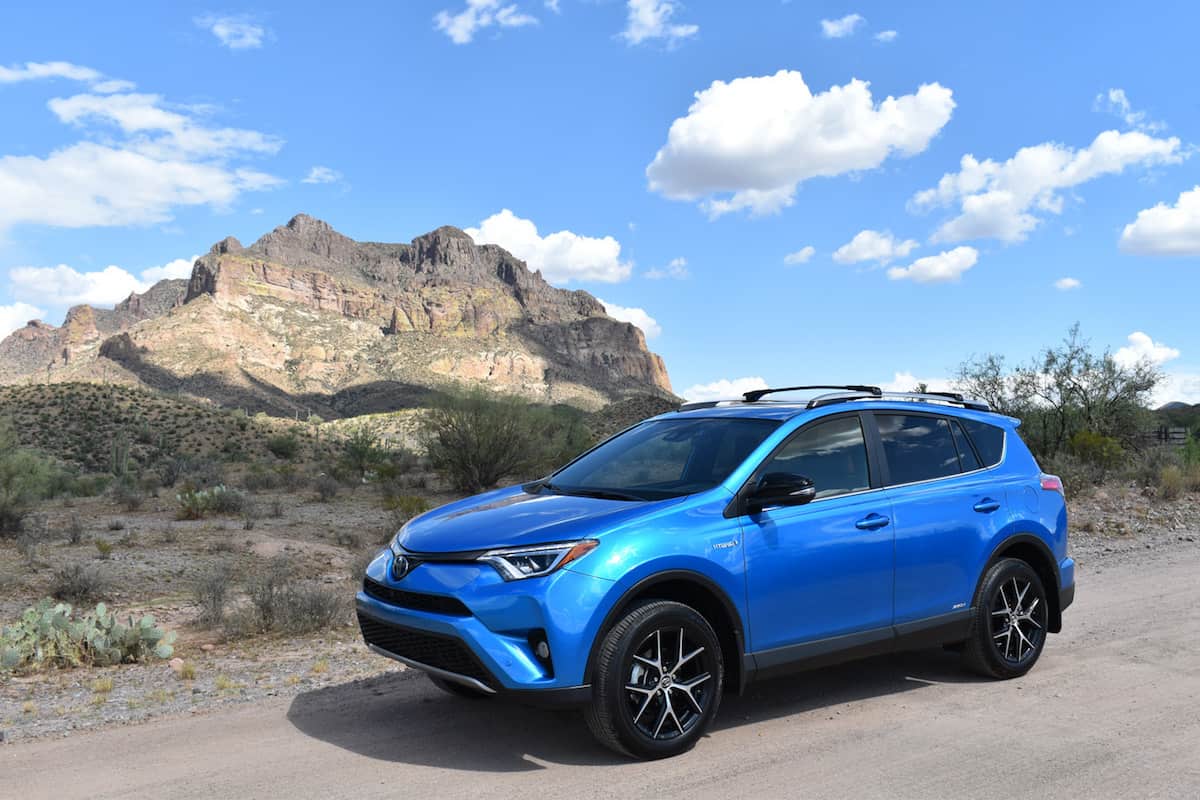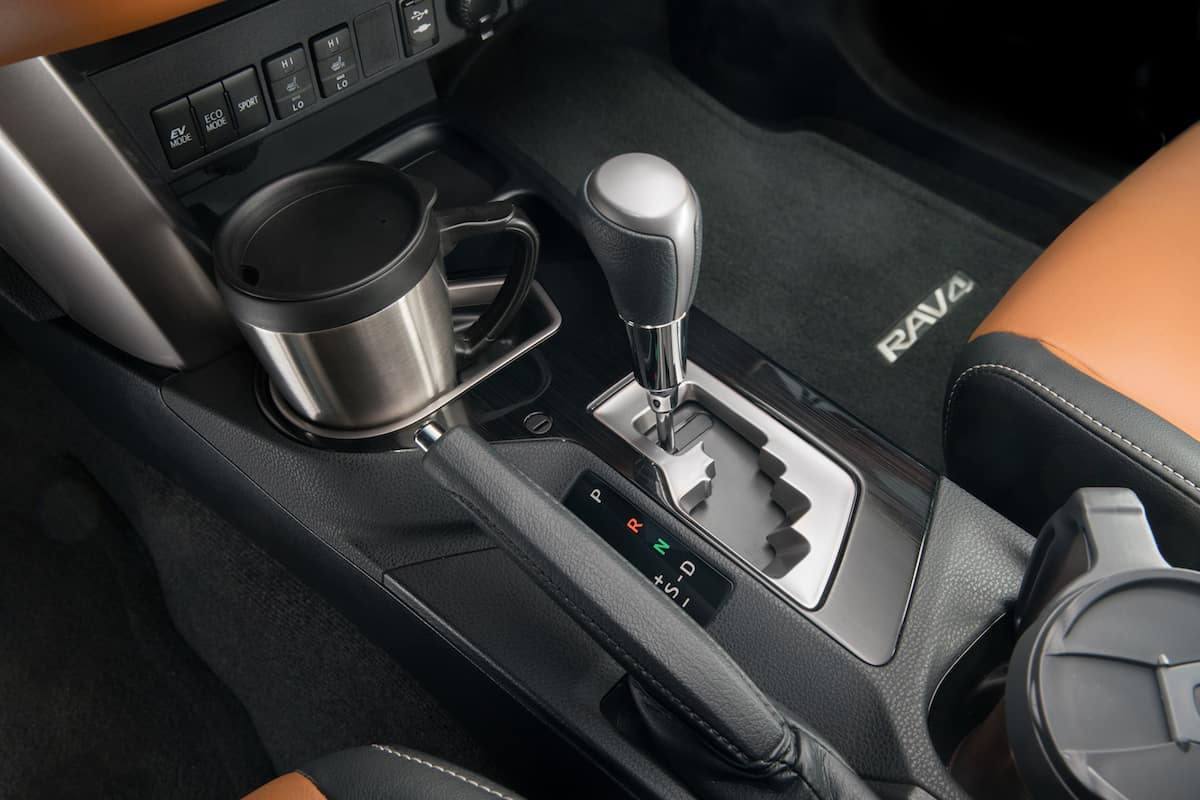Phoenix, Arizona – Toyota was a pioneer in both petrol-electric hybrid technology and the compact crossover segment. Those two strands came together at the beginning of 2016 with the launch of the RAV4 Hybrid. It’s a package that’s unusual for the class – the Nissan Rogue Hybrid being the notable rival – for now, at least.
The current-generation RAV4 was introduced in 2013 but was facelifted for the 2016 model year. For 2017, Toyota added standard pre-collision braking, lane departure warning, adaptive cruise control and automatic high-beam headlights to all models and introduced the SE as a mid-range Hybrid trim level between the XLE and Limited. We spent a few days living with an eye-catching, Electric Storm Blue SE in the summer heat of Arizona and New Mexico.
RAV4 SE Exterior: Carried over from 2016
The 2017 model has Toyota’s latest family face and some fashionable LED running lights, but it’s still unmistakably a RAV4, which is no bad thing. The SE Hybrid’s 18-inch alloy wheels, fitted in our case with Bridgestone 235/55 R18 low-rolling-resistance rubber, look good, too, although this combination is not without its compromises, as we’ll see.
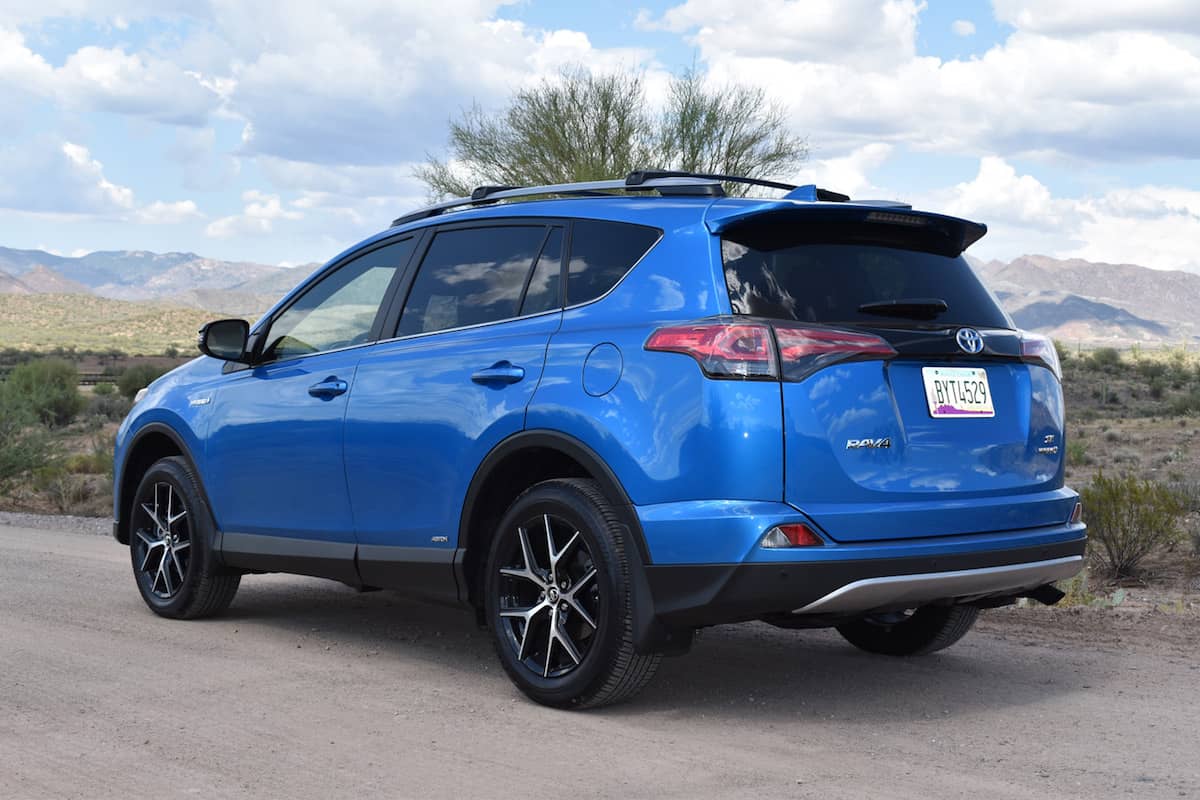
Toyota RAV4 Interior: do the hybrid batteries hog cabin space?
The RAV4 Hybrid doesn’t want for interior space. The rear seat is especially impressive with good legroom and an open, spacious feel. Luggage capacity is reduced by 2 cu. ft. from a regular RAV4 by the battery pack’s intrusion into the trunk floor. The cargo volume is still good for the class however – around 5 cu. ft. more than a Mazda CX-5 for example – and multiple folding rear-seat options give you some loading flexibility if the second row isn’t fully occupied.
Main cabin features
The SE Hybrid model is already well equipped but the test car came with the US$2,450 Advanced Technology Package, which includes niceties like a 360° overview camera, a premium JBL audio system, a nifty Gracenote cover art display and a very accurate predictive-traffic navigation system.
For me however the overall feel of the dashboard was a little dated with a definite familiarity to the switchgear, some elements of which have faithfully served Toyota for a decade or more. There’s no doubt that some class rivals have more stylish interiors. Finally, although the leather seats are comfortable on long runs, they failed to keep our backs cool on some admittedly very hot days.
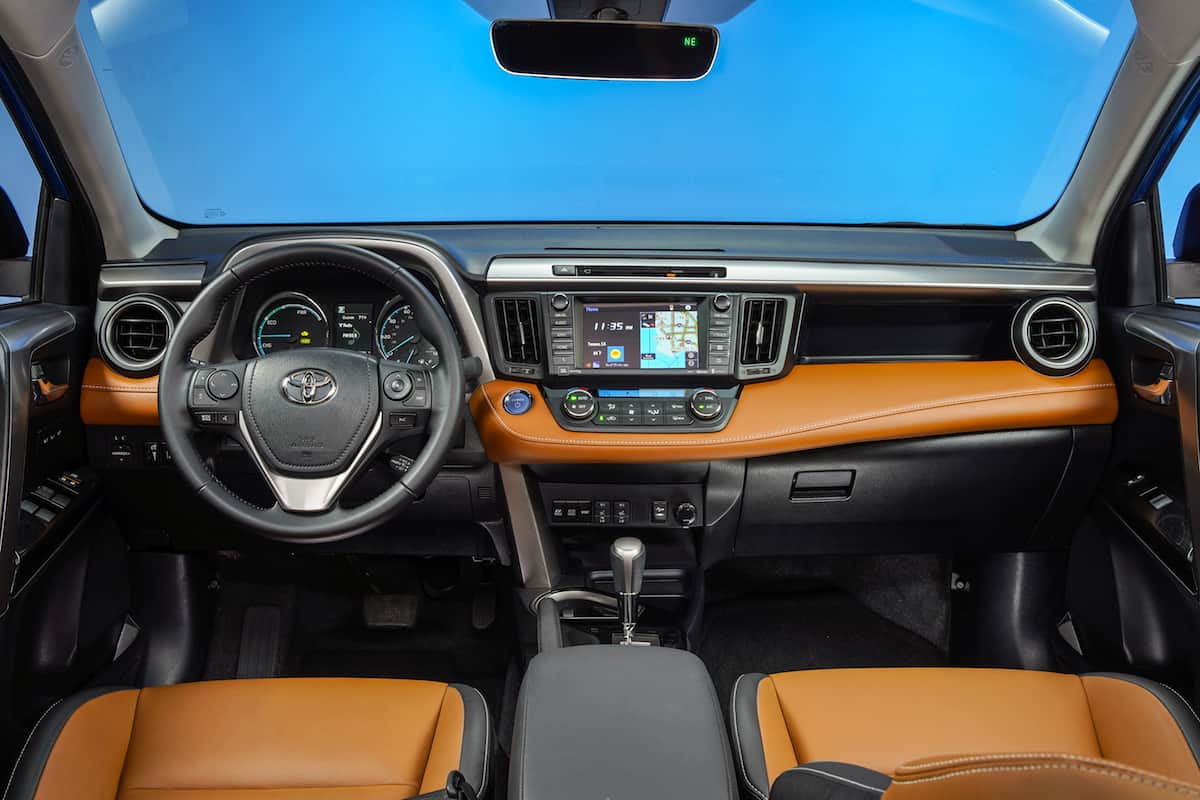
RAV4’s Hybrid powertrain: a 2.5L engine and electric motors
The RAV4’s Hybrid Synergy Drive powertrain consists of a 2.5-liter gasoline engine running on the Atkinson cycle (whereby fuel is saved by a delayed closing of the intake valve during the compression stroke) and electric motors front and rear to provide AWD capability. Electrical energy is stored in a rear-mounted Nickel-Metal Hydride battery pack and the transmission is CVT rather than a conventional auto.
It’s the same setup that you’ll find in the Lexus NX300h and offers 194 combined horsepower. With the RAV4 no longer available with a V6, the Hybrid is now the most powerful model in the range. Combined EPA fuel economy is 32mpg however, a useful 6mpg increase over the non-hybrid model for a price premium of US$2,000 versus a non-hybrid SE. Battery charge is only via the engine’s motor-generator and regenerative braking; no plug-in option here.
Driving impressions
On the road the first impressions aren’t great, unfortunately. At low speeds, this RAV4 displayed some disappointing ride shake as soon as the surface deteriorated from perfect asphalt. The cabin’s isolation from imperfections in the road isn’t good, and noticeably worse at the rear, where the suspension may have been stiffened up to support the extra weight of the battery.
As is often the case, the big rims and low-profile tires don’t help the cause. In addition, the steering is also over-assisted at low speeds and provides little feel for what the front wheels are doing, which limits the RAV4’s appeal as a driver’s car on Arizona’s twisty canyon roads.
…it’s hard to overlook the disappointing low-speed ride and refinement, in this trim level at least – which would likely be improved by smaller wheels – and uninvolving driving experience.
Things pick up at highway speeds, however. The ride is smoother and the vehicle is a quiet cruiser. The steering returns to a sensible weight, too. The only disappointment is an odd behavior by the cruise control, which won’t set to a new, higher speed – for example, when you exit a construction zone – without first being switched off and on again.
2017 RAV4 Hybrid Fuel Economy
Making use of the electrical elements of the powertrain was also a game of two halves. A 30mph-ish speed restriction and a limit to throttle travel before the combustion engine kicks back in, are frustrating but not unexpected features of this type of hybrid system. The setup came into its own in a couple of hours of stop-start traffic, however, boosting fuel economy and cutting local air pollution in exactly the way it’s supposed to. The official city consumption figure for the Hybrid, for example, is 34mpg to the non-hybrid 2.5’s 23mpg. We were also grateful for the regenerative braking, which helped to keep the friction brakes cool on a long downhill section of highway. (Of interest, also check out Hybrid Cars Pros and Cons and Ownership Costs).
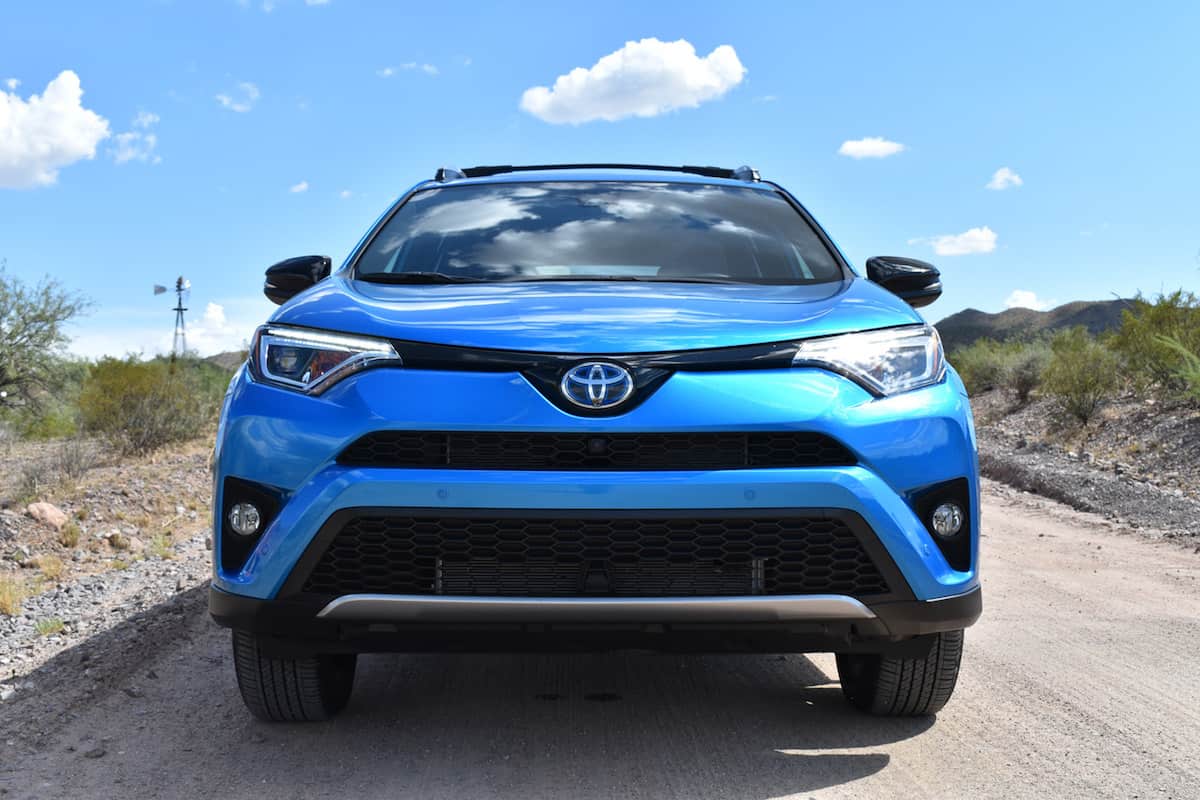
Takeaway: is the 2017 hybrid-powered RAV4 SE worth it?
Pros
- Spacious interior
- Hybrid economy, especially on congested roads
- Smooth and quiet in the cruise
Cons
- Uninvolving driving experience
- Frustrating cruise control
- Avoid big wheels to improve low-speed ride comfort
Toyota has been in the hybrid game a long time and it shows – the integration of the electrical elements here with the conventional powertrain is seamless. The car looks good, is well equipped and there’s no reason why it won’t benefit from its maker’s reputation for solid reliability. The RAV4 Hybrid’s fuel efficiency credentials aren’t in doubt, either; conversely, it’s a useful alternative if you like your compact crossovers with a little more go and/or the security of AWD.
Nevertheless it’s hard to overlook the disappointing low-speed ride and refinement, in this trim level at least – which would likely be improved by smaller wheels – and uninvolving driving experience. Toyota has recently upped its game in the ride and handling stakes with well-received models like the C-HR but the RAV4 predates its younger sibling’s New Global Architecture underpinnings. That bodes well for the next generation, by which time new developments in battery and electric-motor technology will likely make it an even more attractive proposition.
Price at release date
While our review here is of the 2017 model, Toyota released pricing for the 2018 RAV4 Hybrids, starting at US$29,030 and/or C$34,635. Our Hybrid SE trim as tested sold for US$32,185 / C$38,840 when it first hit dealerships.
2017 Toyota RAV4 SE Hybrid Review Photos:
Exterior shots by Graham Heeps; Interiors by Toyota

